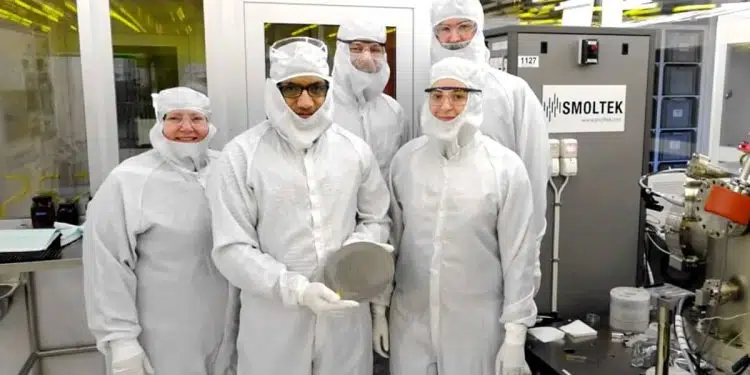Smoltek Nanotech Holding AB (“Smoltek”) announces that the Group company Smoltek Semi AB (“Smoltek Semi”) has signed a Memorandum of Understanding (MoU) with a global manufacturer of capacitors for the joint development of Smoltek’s ultra-thin CMF-MIM capacitors and, provided that the development goals are achieved, mass production and sales via a 50/50-owned joint venture.
The MoU that the two parties have now signed relates to the joint development of a capacitor product and the industrial mass production process for Smoltek’s patented, ultra-thin carbon nanofiber (CNF-MIM) capacitors. The initial part of the project will be defined in a Joint Development Agreement (JDA), where 1.5 million USD will be paid to Smoltek Semi for continued development work when the development agreement has been signed. The MoU also refers to the potential formation of a 50/50-owned joint venture which, if it is formed, will receive a license for mass production and sales of CNF-MIM capacitors in the discrete capacitors segment. The capacitor manufacturer has, in the event of the joint venture being formed, undertaken to take responsibility for the day-to-day operations of the planned joint venture, as well as to invest a total of 3.5 million USD in the development project, of which 1.5 million USD will be paid to Smoltek Semi when the planned Joint Development Agreement (JDA) for the initial part of the project has been signed.
Smoltek Semi has been collaborating with a global manufacturer of passive components for the evaluation of Smoltek’s patented technology platform, which enables manufacturing of ultra-thin carbon nanofiber capacitors, since 2020. The evaluation license agreement for this collaboration has been gradually extended, most recently to the end of June 2022, with the purpose to reach an agreement on the terms of the MoU which has now been signed.
The MoU means that Smoltek Semi and the capacitor manufacturer have now agreed on the overall terms and initial financing to bring Smoltek’s patented CNF-MIM technology for ultra-thin capacitors to market in the discrete capacitors segment, and to mass-produce and sell these capacitors via a 50/50-owned joint venture.
“This agreement with a global capacitor manufacturer is a historic milestone for Smoltek. We now have a perfect partner in place to complete a competitive product and industrial mass production process for our ultra-thin CNF-MIM capacitors. Given that we succeed in this, the joint venture that we plan to start will have excellent conditions to take a significant share of the market for decoupling capacitors by utilizing our partner’s established network in the semiconductor industry. I am very proud of Smoltek’s entire team that has made it possible to take such an important step closer to our goal of becoming an innovative industrial company based on our patented nanotechnology platform,” says Smoltek’s CEO Håkan Persson.
More about the MoU and the way forward
The MoU defines two phases, of which Phase 1 begins after negotiations and signing of a Joint Development Agreement (JDA) which will regulate the parties’ responsibilities and commitments. The JDA is expected to be signed in the near future and Phase 1 is expected to be completed during the second half of 2023.
Phase 1 includes product development and industrial process development for discrete CNF-MIM capacitors. The capacitor manufacturer will invest 1.5 million USD at the start of phase 1, while Smoltek Semi’s corresponding investment consists of the carbon growth machine which the company has ordered, as communicated in a press release on March 21 2022, as well as product development and process development at the contract manufacturer.
Phase 2 will begin when a number of predetermined conditions for the performance of the discrete CNF-MIM capacitors have been met. During phase 2, Smoltek Semi and the manufacturer plan to form a joint venture, with each party owning 50 percent. According to the MoU, this joint venture will receive a license from Smoltek for mass production and sales of discrete CNF-MIM capacitors. Commercial and financial terms for the license will be negotiated and decided in connection with the formation of the joint venture. The manufacturer undertakes to initially invest 1.5 million USD in the joint venture, and approximately an additional 0.5 million USD related to production equipment. Smoltek Semi’s corresponding commitment to invest in the joint venture consists of additional investments in production equipment for industrial carbon growth and additional investments in process development. Given that the joint venture is formed, the parties will negotiate regarding additional financing and terms related to running the operating company, as well as the terms for the license mentioned above.
Smoltek’s targets for 2027 for the company’s ultra-thin capacitors
The MoU with a global manufacturer of capacitors is in line with the company’s strategic goals for 2027, as well as the phases and interim goals that remain to achieve these goals, as described in a press release published on May 5, 2022. Smoltek recommends stakeholders who want more information about the company’s overall development from an innovation company to an innovation-driven industrial company to read this press release.































